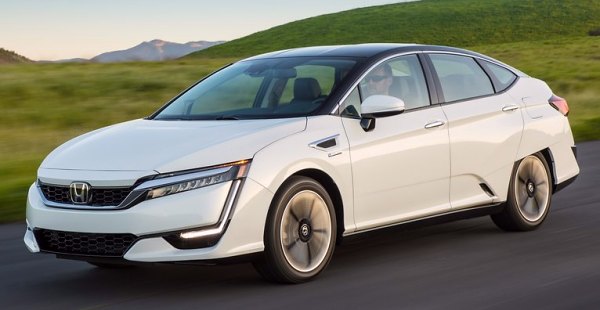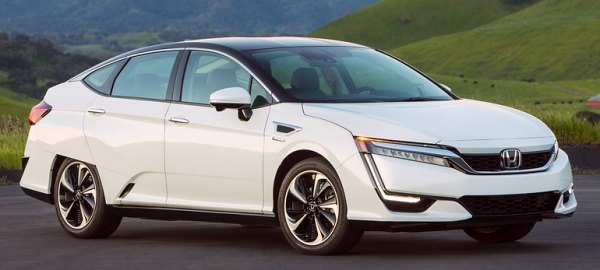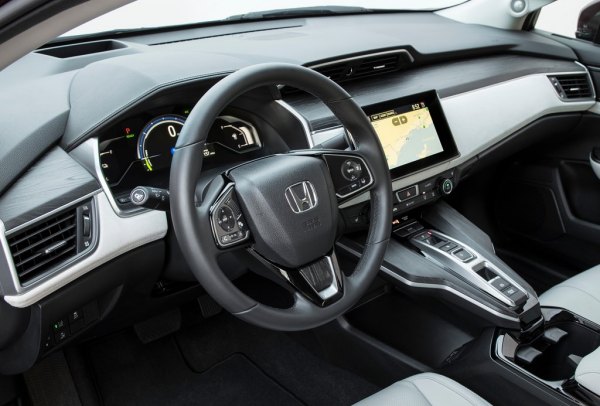Published
on 8
Apr 2017
|
All rights reserved.
|
|
Clarity Fuel Cell
|

|
|
Clarity
is flexible enough to accept 3 powertrain options: fuel cell, EV or
PHEV.
|
|
Remember the FCX Clarity? Honda built a handful of that
car from 2008 as a small-scale experiment of hydrogen fuel cell
technology. It was leased rather than sold to selected customers in
Japan and USA because the technology was not matured enough.
Unfortunately, last year Toyota
Mirai leapfrogged Honda to be the first fuel cell car for sale to
ordinary customers. This year, Toyota is expected to build 3,000
Mirais,
so history will remember it as the first production fuel cell car.
Honda is not going to sit and watch, of course. In fact, it is stepping
up its effort in promoting this technology. However, compared with
Toyota, the once avant-garde Japanese car maker seems to be more
cautious on the prospect of fuel cell technology. Fearing for cold
reception, it decided to share the risk with EV and PHEV technology –
clever, since one of them will win the race eventually. This means, the
new Clarity will be offered with 3 power options: hydrogen fuel cell,
pure battery electric and plug-in hybrid. The strategy is not unlike
Hyundai with its Ioniq (which offers hybrid, PHEV and EV but not fuel
cell, even though the company had another fuel cell car). The design of
the Clarity is flexible enough to accept these power options without
making expensive modifications. Launched first is the Clarity Fuel
Cell, whereas the other two will come later this year.

|
|
Its
old-fashioned shape recalls our memory of Citroen CX...
|
|
At the first glance, the Clarity looks disappointingly conservative,
especially considering its predecessor looked so futuristic. Its long
front and rear overhangs look old fashioned, and its overall shape, as
well as the semi-covered rear wheel arch, recalls our memory of Citroen CX. That would have
been a praise 40 years ago, but now it looks just outdated, even though
Honda deliberately added a lot of flashy details to smart it up. That
said, compared with the ugly Mirai it is still easily the most
beautiful fuel cell car in the world, unfortunately.
Honda declines to tell us its drag coefficient, but I suppose it won’t
be remarkable because fuel cell cars need a lot of cooling, which is
evident from the Clarity’s extra ventilations adjacent to the front and
rear wheels.
This is a big car, measuring over 4.9 meters in length and weighs some
1890 kilograms, though it is in the same ballpark as Mirai. While the
Mirai has many of its platform components
shared with Lexus HS250h, the Honda is largely new. Its steel monocoque
chassis has aluminum front and rear subframes to mount the powertrain
and hydrogen fuel tanks respectively. The suspension of struts up front
and
multi-link setup at the rear employ forged aluminum control arms and
hollow knuckles to reduce unsprung weight. They are served with
amplitude selective dampers to improve ride and handling. Outside, the
bonnet, fenders, doors and boot lid are made of stamped aluminum.

|
|
The
fuel cell, electric motor and inverter are packaged like a conventional
engine.
|
|
The most interesting to me is what lies underneath the monocoque
structure. This picture illustrates the placement of its propulsion
components, which is rather different from the approach of Toyota. To
enable the multiple powertrain options, Honda puts the hydrogen fuel
cell stack on the top of the electric motor/single-speed gearbox, and
the power electronics/inverter unit tops them. This means, the 3 are
packaged remarkably like a conventional engine under the bonnet, so
they can be easily exchanged with an EV or PHEV powertrain. Expectedly,
the latest generation of Honda hydrogen fuel cell is more efficient
than the one of FCX Clarity. Its efficiency has surpassed 60 percent,
compared with just over 50% of the old unit. This means it can be made
33% smaller, with 30% fewer cells yet produces slightly more power. It
can supply a continuous 103kW (140hp) to the permanent magnet AC
electric motor, which is capable to produce 177 hp and 221 lbft of
torque to the front wheels. The difference between motor and fuel cell
output can be supplemented with a 1.7kWh lithium battery which is
located under the front seats. At full thrust, the battery power can
last for about 3 minutes. In the real world, unless you abuse the Honda
like Fernando Alonso to his McLaren-Honda, it should be able to find
some breathing space to recharge the battery, such as during
regenerative braking.
Like Mirai, there are 2 high-pressure (700 bar) hydrogen fuel tanks,
the smaller one is placed under the rear seat and the larger one
occupies a substantial part of the boot, reducing luggage space to 334
liters. They provide a claimed driving range of 750 km in Japanese
cycle, although in the real world it is much shorter.

|
|
Most
of the surfaces are covered with recycled materials that look and feel
good...
|
|
Although the Clarity is slightly larger than Accord in all dimensions,
its interior is on the contrary. In particular, rear legroom is cut by
45mm, while headroom is reduced by 10mm despite its taller roof, blame
to the hydrogen fuel tanks. That said, it is still roomy enough to sit
5 adults. On the positive side, the cabin is quite stylish and finished
in premium build quality. Most of the surfaces are covered with
recycled materials that look and feel good, not to mention the
environmental-conscious image they deliver.
At the back, the boot is even less usable than the number suggested.
While it has no problem to accommodate a couple of golf clubs, it is
simply too short to place large suitcases. There is no folding back
seat or pass-through for longer items either, blame to the cumbersome
gas tank again.
On the road, the Clarity runs with remarkable refinement. There is some
breathing noise from the electric air compressor that feeds the fuel
cell, but the cabin is very well insulated with its laminated glass and
sound insulating materials. Like Mirai, the power and performance is
adequate, focusing on smoothness and quietness rather than excitement.
The instant torque of electric motor satisfactorily masks its heft.
0-60 mph is expected to take 8 and a half seconds, slightly faster than
the Mirai if still not anything to write about. Top speed is limited to
only 105 mph though.

|
|
It
drives just like a heavier Accord...
|
|
In corners, the Honda displays better handling than the Toyota. It
rolls less and holds the road stronger than the Mirai, thanks to its
lower center of gravity and better suspension. In fact, it drives just
like a heavier Accord, with similar steering (precise and linear),
braking (well modulated) and ride (smooth and composed), though you
won’t confuse it with a driver’s car. It has a front-to-rear weight
distribution of 57:43 like conventional FF cars. Many EVs achieves
50:50 and lower center of gravity.
If the Clarity Fuel Cell is priced at the same level as a top-spec
Accord or even Acura TLX, it would have earned a 3-star rating.
However, since it has a list price of $60,000 in the US market, it is
hopeless. In fact, despite the quoted price, you are not able to buy it
unless you live in Japan, where it is sold only to the government and
selected customers at the same price as a Mercedes E-class! No matter
buy or lease, you are taking advantage of Honda because the car is way
more expensive to develop and build. Worse still, there are very few
hydrogen refill stations in both countries at the moment. It might take
a decade or so to become widely available, even if with the support of
governments and energy industry. Clarity might be an interesting
technology showcase, but there is little clarity in its prospect.
|
Verdict:   |
Published
on 14
Dec 2017
|
All rights reserved.
|
|
Clarity Plug-in Hybrid
|
|

|
|
Honda’s
take on plug-in hybrid is high on electric and low on engine...
|
|
Together with Toyota,
Honda was the first manufacturer to put alternative fuel vehicles into
mass production. However, so far it has been met with limited success –
or more precisely speaking, mostly failures. The first two generations
Insight, the Civic Hybrid and Accord Plug-in Hybrid have all been
withdrawn without replacement. As for fuel cell vehicles, FCX Clarity
and Clarity Fuel Cell are merely produced in experimental scale.
Nevertheless, Honda is not going to surrender yet. Its new Clarity
offers a platform so flexible that it can accommodate not only hydrogen
fuel cell power but also plug-in hybrid and pure electric power. This
means, no matter which technology wins in the future, Honda won’t be
left behind. We saw the hydrogen fuel cell earlier this year. Now it is
time for the plug-in hybrid.
Unlike many rivals, Honda’s take on plug-in hybrid is high on electric
and low on engine. Its gasoline motor is a small, 1.5-liter naturally
aspirated 4-cylinder, and it runs in Atkinson cycle to save fuel, so
its maximum output is merely 103 hp. In contrast, the front-mounted
electric motor produces 181 hp and 232 lbft of torque. Predictably, in
normal driving the car is powered by purely the electric motor. The
engine fires only when the battery dries up or when maximum power is
required. In the former case, the engine drives a generator to recharge
the battery. In the latter case, a clutch locks the engine and motor
together to provide a combined 212 hp. Because the engine is rarely
used to power the front wheels directly, Honda ditches a conventional
e-CVT to save weight and money.
Weighing 1838 kg, the Clarity Plug-in Hybrid is just a few dozen kilos
lighter than its Fuel Cell sister, whereas an Accord is 400 kg lighter
still! This inevitably blunts its performance and handling. The car is
expected to do 0-60 mph in about 8 seconds, not too bad, but the base
Accord is almost a second quicker. By placing the 17kWh battery pack
underneath the front and rear seats, Honda claims its center of gravity
is lower than conventional cars. Even so, you won’t call the car
sporty. While its balance and steering are decent, the Michelin energy
saving tires lack bite to cope with its weight, so its cornering limit
is unusually low. What it does best is cruising, as it delivers big car
smoothness, quietness and solidity. Unfortunately, such a superb
refinement could be ruined by the loud engine once the battery runs
dry. A bigger and better engine could be the answer, but the downside
would be weight, cost and packaging.
Surprisingly, the Clarity Plug-in Hybrid is well priced in the USA. If
you can get the Federal incentive of $7500, even the fully loaded model
will slip under $30,000. Bear in mind that the car’s interior looks and
feels like a true premium product, this price sounds quite attractive.
No wonder Honda expects it to be by far the best selling variant of
Clarity. For us, however, the Accord is a much better bet.
|
Verdict:    |
|